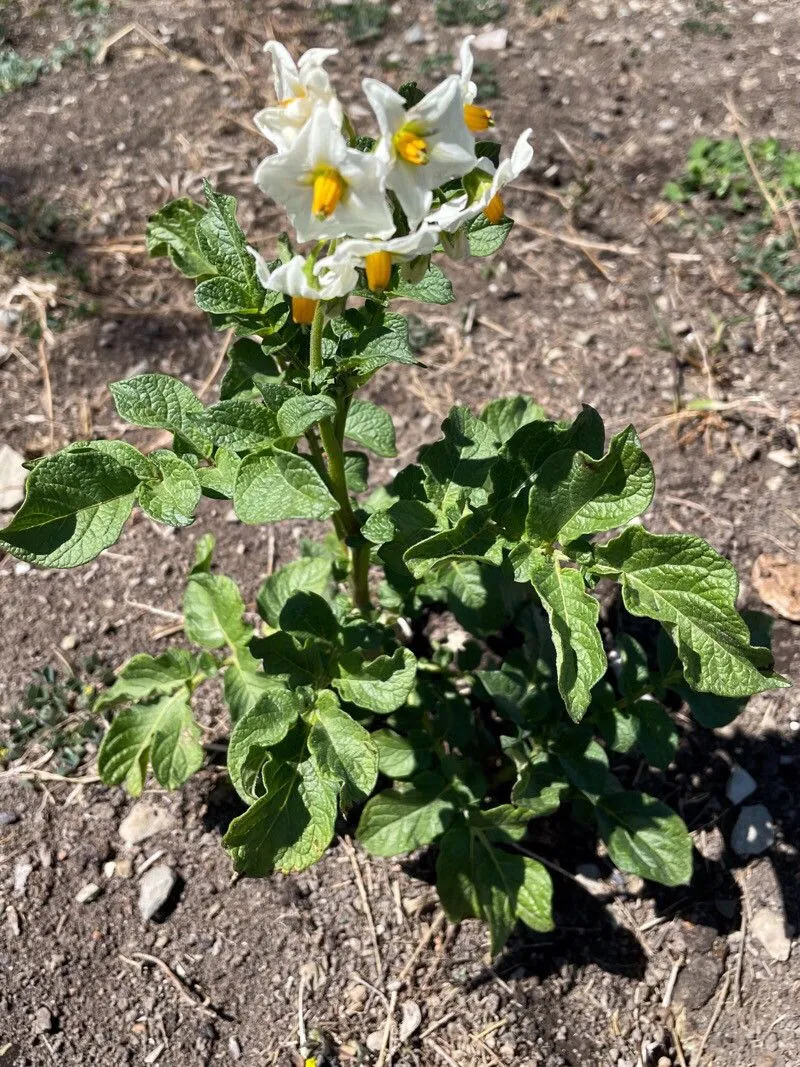
Author: L.
Bibliography: Sp. Pl.: 187 (1753)
Year: 1753
Status: accepted
Rank: species
Genus: Solanum
Vegetable: False
Observations: E. Canada to N. Mexico, Haiti
Carolina horse-nettle, known scientifically as Solanum carolinense, is a notable plant species that draws attention both for its beauty and its impact on ecosystems and agriculture. This intriguing plant belongs to the Solanaceae family, a group known for its diverse and economically significant members, including tomatoes, potatoes, and eggplants.
Originally documented in 1753, Carolina horse-nettle is widely distributed across eastern Canada and extends its reach into northern Mexico, also making its presence known in Haiti. Its geographic range reflects the plant’s adaptability to various climates and soil types.
As an herbaceous perennial, Carolina horse-nettle can grow up to 3 feet tall, often forming dense, thorny thickets. The plant’s stems and leaves are covered in sharp spines, which serve as a defense mechanism against herbivores. The leaves are dark green, ovate to lanceolate in shape, and emit a distinctive odor when crushed, a characteristic trait of many Solanaceae family members.
One of the most striking features of Carolina horse-nettle is its flowers, which can be light violet to white and typically bloom from May to September. These star-shaped flowers are about 1 inch in diameter and are composed of five petals fused at the base, surrounding bright yellow stamens. Following the blooming period, the plant produces small, spherical berries that transition in color from green to yellow as they mature. While these berries may appear appealing, they are toxic to humans and many animals if ingested.
Carolina horse-nettle is often regarded as a weed due to its aggressive growth and resilience. It can quickly establish in disturbed areas, pastures, and cultivated fields, where its presence can lead to reduced crop yields and difficulties in land management. Its underground rhizomes contribute to its ability to spread and regenerate, even after attempts to remove it.
Despite its invasive tendencies and toxicity, Carolina horse-nettle also plays an ecological role. It provides food for certain insect species and serves as a host for various bugs and beetles that can pollinate other plants. However, managing its spread is crucial in agricultural and natural settings to prevent the displacement of native flora and mitigate its harmful effects on livestock.
In conclusion, Solanum carolinense, or Carolina horse-nettle, is a plant of contrasts—its delicate flowers and vibrant berries hide a tough, thorny structure, and its beauty belies its potential to become a troublesome weed. Understanding and managing this plant is essential for maintaining balanced ecosystems and productive agricultural lands.
Eng: apple of sodom, ball nightshade, ball-nettle, bull nettle, carolina horse-nettle, carolina horsenettle, devil’s tomato, horse-nettle, horsenettle, sand briar, carolina nightshade, apple-of-sodom
Deu: carolina-nachtschatten, karolina-nachtschatten
Lit: karolininė kiauliauogė
Ces: lilek karolínský
Swe: “stickskatta “
Nld: carolina-nachtschade
Fra: morelle de caroline
Cym: marchddanadl, marchddanhadlen
En: Carolina horse-nettle, Ball nightshade, Ball-nettle, Horse-nettle, Carolina horsenettle, Carolina nightshade, Apple of Sodom, Bull nettle, Devil’s tomato, Horsenettle, Sand briar, Apple-of-Sodom
Cs: Lilek karolínský
Nl: Carolina-nachtschade
Fr: Morelle de Caroline
De: Carolina-Nachtschatten, Karolina-Nachtschatten
Lt: Karolininė kiauliauogė
Sv: “stickskatta “
Cy: Marchddanadl, Marchddanhadlen
Taken Sep 17, 2020 by Damien F (cc-by-sa)
Taken Jul 2, 2020 by E G (cc-by-sa)
Taken Jun 22, 2021 by cali caw (cc-by-sa)
Taken Jul 12, 2022 by joe banks (cc-by-sa)
Taken Jul 1, 2018 by Mary Pierce (cc-by-sa)
Taken Jul 17, 2017 by Reiner Petzoldt (cc-by-sa)
Taken Jun 20, 2022 by Rivera Noah (cc-by-sa)
Taken Jun 25, 2021 by john hyde (cc-by-sa)
Taken Jul 15, 2021 by John Stone (cc-by-sa)
Taken Aug 15, 2018 by James Ratzlaff (cc-by-sa)
Taken May 25, 2018 by Tonelotto Anibal (cc-by-sa)
Taken Oct 21, 2021 by rgallagher562 (cc-by-sa)
Taken Nov 12, 2022 by Tom Cagley (cc-by-sa)
Taken Nov 2, 2022 by Jillian Kurek (cc-by-sa)
Taken Feb 9, 2021 by Lee Holley (cc-by-sa)
Taken Aug 31, 2022 by Jim Knopf (cc-by-sa)
Taken Aug 21, 2021 by yangsheng zhang (cc-by-sa)
Taken Nov 12, 2022 by Eli Small (cc-by-sa)
Taken Mar 3, 2022 by Naaf Guta (cc-by-sa)
Taken Jun 8, 2020 by Robert Breeding (cc-by-sa)
Taken Aug 15, 2018 by Photoflora – Corine OOSTERLEE (©)
Taken Jun 29, 2022 by Nicole Barnett 79 Barnett (cc-by-sa)
Taken Aug 15, 2018 by Photoflora – Corine OOSTERLEE (©)
Taken Aug 15, 2018 by Photoflora – Corine OOSTERLEE (©)
Taken May 15, 2021 by Matt Miller (cc-by-sa)
Taken Oct 2, 2004 by EOL − Steven J. Baskauf (cc-by-nc-sa)
Taken Jun 6, 2003 by EOL − Steven J. Baskauf (cc-by-nc-sa)
Taken Jun 25, 2002 by EOL − Steven J. Baskauf (cc-by-nc-sa)
Taken Sep 29, 2014 by EOL − arebee (cc-by-nc)
Taken May 24, 2020 by Kyle Grubb (cc-by-sa)
© copyright of the Board of Trustees of the Royal Botanic Gardens, Kew.
© copyright of the Board of Trustees of the Royal Botanic Gardens, Kew.
© copyright of the Board of Trustees of the Royal Botanic Gardens, Kew.
Growth habit: Subshrub, Forb/herb
Family: Myrtaceae Author: (F.Muell.) K.D.Hill & L.A.S.Johnson Bibliography: Telopea 6: 402 (1995) Year: 1995 Status:…
Family: Rubiaceae Author: Pierre ex A.Froehner Bibliography: Notizbl. Bot. Gart. Berlin-Dahlem 1: 237 (1897) Year:…
Family: Sapindaceae Author: Koidz. Bibliography: J. Coll. Sci. Imp. Univ. Tokyo 32(1): 38 (1911) Year:…
Family: Asteraceae Author: A.Gray Bibliography: Pacif. Railr. Rep.: 107 (1857) Year: 1857 Status: accepted Rank:…
Family: Fabaceae Author: Medik. Bibliography: Vorles. Churpfälz. Phys.-Ökon. Ges. 2: 398 (1787) Year: 1787 Status:…
Family: Aspleniaceae Author: (Cav.) Alston Bibliography: Bull. Misc. Inform. Kew 1932: 309 (1932) Year: 1932…